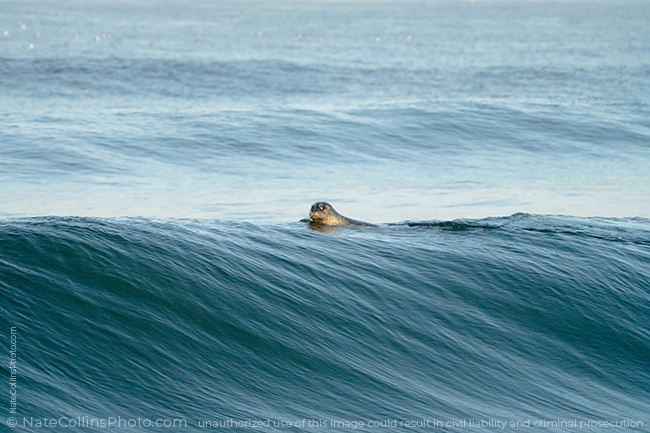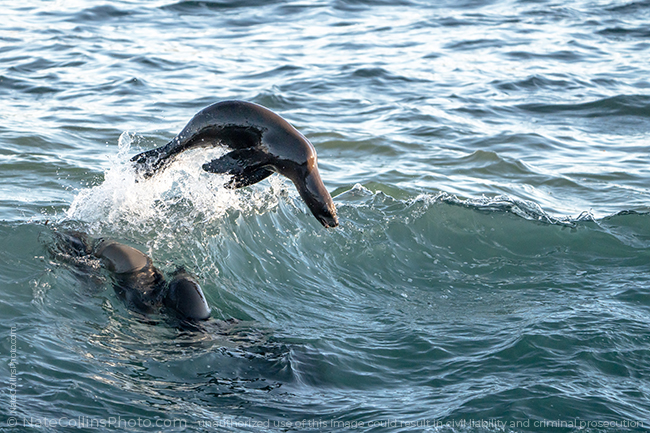I hope you enjoyed scrolling though some of my favorite Wildlife Images. Most of these photographs are animals in their natural habitats located in Coastal San Diego.
Favorites

Dolphin Photos by Nate Collins
These images feature dolphins in the wild off Pacific Beach and Mission Beach in San Diego.
Dolphins are a fun subject and popular images for a variety of reasons. As sophisticated air breathing mammals with incredible communication skills Dolphins have many will enjoy parallels between dolphin and human behavior.
The local dolphins are family oriented and typically you’ll see a variety of sizes in each pod group. In fact some of my favorite shots are larger dolphins surfing with younger, smaller dolphins.
Both the surfing and jumping images represent a lot of miles walking north and south along the beach following pods of dolphins. Typically I’ll wait near the split between Pacific Beach and Mission Beach and watch past the breaking waves usually just outside where surfers might line up. Unless they’re exceptionally motivated for some reason its not too hard to pace them along the shoreline. I find they tend to traverse about 3mph – a 20 minute mile.
Depending on their moods they’ll break the surface in longer or shorter intervals. When I find they are cycling on the surface in shorter frequency, arcing out of the water more often, that’s when they seem more likely to be excited and jumping or surfing.
You might see their fins and follow them up and down the beach without seeing anything for days. But when you see them play it’s always an amazing experience.
Shooting dolphins jumping is one of my favorite challenges. Unlike land animals or birds shooting action images of dolphins leaping out of the water for a mere second or seconds. Seldom is the first jump captured, so you’re hoping that as a group the dolphins begin to play together and you can get the camera in place. Often you’ll find yourself starting a focus point on the water and as the dolphins jump you can adjust the focus point quickly.
Dolphins use the energy of the wave to propel themselves forward or out the back and over breaking waves. Both are incredible to see and when you capture the moment it produces a fun image.
Occasionally I’ll see Dolphins surf or jump in a group of surfers, however, more often they seem to get close to the edge of the surfers and “show off” there.
When very excited its fun to see them run in with the waves nearly all the way to the edge of the surf. I’ve had experiences where I could nearly splash them as they make a turn back to deeper water – so close I have too much lens on the camera to even capture it.
Unlike Seals and Sea Lions the Dolphins tend to behave like animals with less predators and have movements that can be easy to predict and track.
It seems like the Dolphins overall behaviors are highly influenced by the group. It’s rare to see one or two in a group playing, jumping, splashing or surfing while the majority simply swim. More often one or two in the pod motivate the others to play.

Seal Photography by Nate Collins
Seals are one of my favorite photography subjects. Like Dolphins there are a lot of miles walking down the beach with a Seal to capture a fun image. Also like the Dolphins I find that I can follow seals at about a 20 minute mile, maybe slightly faster.
Unlike Dolphins, Seals behave as you would expect an animal that is considered prey for more apex animals. Seals tend to have a slightly less predictable pace as they move inside the surf line as well as varying their distance from the edge of the water often.
Outside of La Jolla most of the Seals I encounter are solitary. Along Pacific Beach and Mission Beach I’ve come across Seals in a wide range of sizes. Overall the midsized Seals tend to seem the most interested in me as they see me a few times when they surface.
Seals have interesting and unique patterns and I will occasionally come across the same Seal off the beach.
Getting good photos of Seals is a rewarding feeling based on the amount of time you may have to follow them and how erratic their surfacing patterns may be. I find them fairly photogenic – particularly contrasted with whitewash from breaking waves, although, I tend to photograph in the morning and they will close their sun facing eye a bit for better visibility which can make for an awkward face!
When people ask me tips to spot a Seal at the beach I tend to tell them to look for an anomoly between the edge of the water and the first set of breaking waves. You will tend to notice a dark spot, similar to the size of a human head but one hundred times more graceful and at ease in the water than any human looks. I’ve seldom seen them turn around so I follow the way they were facing and scan a swath of the water for another anomoly.
Seals will even pop out to look at you exceptionally close up. A handful of times I’ve missed them at first because I don’t have the lens setup for less than 10 yards focus or I have too much lens to focus that close. This is really notable at low tide where there can be a “step” in the water where it goes from relatively shallow to thigh or waist deep quickly.

Sea Lion Photography by Nate Collins
Like Dolphins it’s fun to photography Sea Lions. They tend to play in groups and definitely enjoy their surroundings. Watching them surf, jumping in and out of waves is exciting and shows a level of enjoyment of existence in their worlds. Watching animals play for plays sake is an eye opener to the level of brain function they’re capable of.
Most of the Sea Lion photography on my site is from La Jolla Cove. A large group of Sea Lions lives there hauling out on the large rock outcroppings as well as using the beach to thermoregulate.
Occasionally I will see Sea Lions in the surf off Mission or Pacific Beach and can find them in areas like the Quivira Basin resting on the commercial docks.
I tend to end up at La Jolla Cove when the surf is notably big or after storms as I tend to stay out of the water after the rain for a few days.
Some of my favorite Sea Lion photos are from large days where they play in the surf both in the cove as well as the break outside of the cove called Boomers.
While access to the Sea Lions at La Jolla is fairly easy it’s important to always give them their space. They’re much bigger and faster than one might think and are wild animals with no tolerance for people encroaching their space.
Equally as important – Sea Lion mothers are known to abandon pups if people interfere. There’s no “selfie” worth that. If you go to La Jolla Cove give them their space and enjoy watching their natural behavior.
The wildlife photos are popular for animal lovers as well as those who appreciate the unique color and textures. Often it’s the color transition or contrasting textures that draw people towards a particular picture.
This collection includes range of nature photos are available of coastal mammals like Dolphins, Seals and Sea Lions. Shorebirds such as Brown Pelicans, Cormorants, Snow Egrets, Osprey, Great Blue Heron, Great Egrets and more are highlighted as well.
If you have any questions about the site, these images or my work I invite you to use the contact page for queries.
































